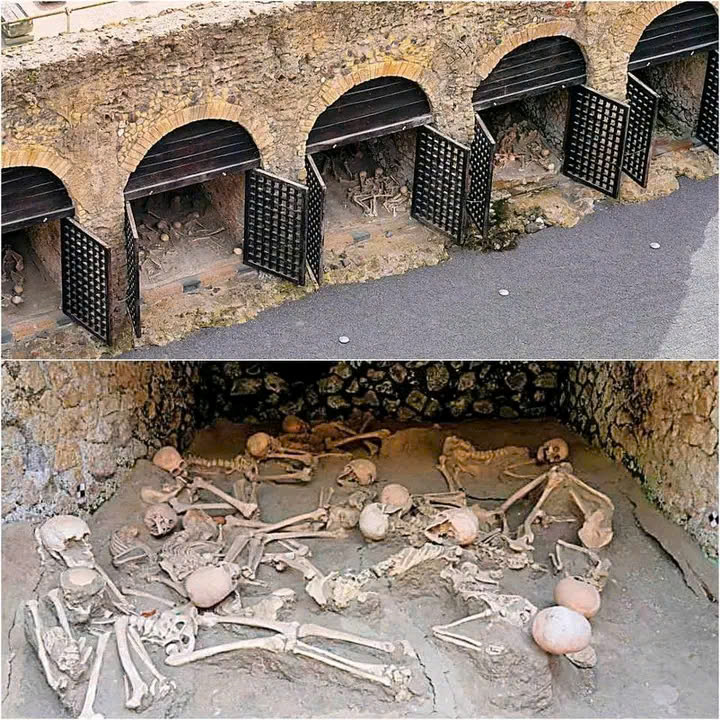The story of Herculaneum is far more than an archaeological marvel—it’s a deeply moving testament to the vulnerability of human life and the overwhelming, unpredictable force of nature. In the year AD 79, when Mount Vesuvius erupted with unimaginable fury, the once-bustling Roman city of Herculaneum, nestled on the coast of the Bay of Naples, was transformed in an instant. What had been a vibrant, thriving community full of culture and life became frozen in time, a tragic scene of desperation and loss that would echo through the ages.

The horror of that day is difficult to fully comprehend. Pyroclastic surges—blisteringly hot currents of gas and volcanic debris—raced down the slopes of Vesuvius at terrifying speeds. These flows reached temperatures exceeding 500 degrees Celsius (over 900 degrees Fahrenheit), incinerating and burying everything in their path. Unlike many other ancient disasters that leave little trace of their victims, Herculaneum provides a uniquely vivid and haunting picture of human tragedy. Near what was once the ancient shoreline, archaeologists uncovered more than 300 skeletons clustered together in boathouses and along the seafront. These people, men, women, and children alike, had fled toward the water in a desperate attempt to escape. They likely waited for rescue ships, never imagining that the very place they sought as a refuge would become their final resting ground.
Yet these skeletal remains are not just relics of the past. They are deeply personal stories etched in bone, telling us about the lives of individuals who once laughed, worked, celebrated, and loved. Through careful scientific analysis, researchers have discovered traces of their diets—fish, grains, fruits, and vegetables—woven into their physical remains. These details paint a portrait of a Mediterranean lifestyle intimately connected to the sea and the surrounding land. It was a society that flourished in its diversity, grounded in agriculture and maritime trade, and enriched by everyday customs that remain relatable even now.
Beyond the biological clues, the personal belongings found with the victims speak volumes. Items such as delicate gold earrings, bronze and silver coins, small tools, and humble charms were found close to their bodies. Each of these artifacts reflects the individual character of their owners and offers us a glimpse into their hopes, their social roles, and their daily routines. There is something strikingly human about these findings—a mother’s bracelet, a merchant’s satchel, a child’s toy. These are not merely objects; they are pieces of lives suddenly interrupted.
What truly sets Herculaneum apart from other ancient ruins is the extraordinary level of preservation. While Pompeii, just a few miles away, was buried under layers of volcanic ash, Herculaneum was smothered in molten volcanic material that cooled and hardened with such speed that it preserved not just the structures, but also organic materials like wood, textiles, and even food. This natural process essentially sealed the town in a volcanic time capsule. The victims’ final postures were locked in place, their facial expressions, their final moments frozen with chilling precision. This has given archaeologists a rare and invaluable opportunity: to observe, study, and better understand Roman life in a way that written records alone could never achieve.
Yet Herculaneum is more than just a subject of academic study. Walking through the remains of the Skeleton House—one of the most haunting sites in the ancient city—you are confronted not only with the science of archaeology but also with the essence of shared humanity. There is an undeniable emotional impact in seeing the bones of someone who perished nearly two thousand years ago, lying in the same spot where they took their last breath. The sense of loss is not abstract—it is personal, immediate, and painfully real. Each skeleton becomes a storyteller, whispering of dreams unfulfilled, of families lost, of futures that would never be realized.
This place forces us to reflect. The people of Herculaneum were not strangers to us—they were just like us. They loved their families, worked to build a future, enjoyed meals with friends, and lived each day with the same blend of routine and hope that we do now. Their sudden end, so violent and without warning, reminds us of life’s fragility. It challenges our modern sense of control and permanence, showing how a single natural event can sweep away centuries of human effort in moments.
But in this tragedy, there is also resilience. The very fact that we can learn so much from Herculaneum today is a testament to the power of memory and the drive to preserve our collective past. The bones and artifacts unearthed there have not only survived—they continue to speak. They bridge the vast gap of time between the ancient and the modern world, reminding us that while technology and culture may evolve, the core of the human experience remains the same.
Visiting Herculaneum is not simply about observing the remnants of an ancient civilization. It is a deeply human journey, one that connects us across centuries and continents. The silence of the Skeleton House is heavy, yet it is filled with meaning. It does not speak of just death and loss—it echoes with life, with stories paused mid-sentence, with the haunting beauty of remembrance. Here, the past reaches out to touch the present, and in that moment, we see ourselves—not just as observers of history, but as part of its ongoing story.
The legacy of Herculaneum serves as both a cautionary tale and a tribute. It reminds us of nature’s might, of life’s unpredictability, and of the enduring power of remembrance. More than just an archaeological site, it is a mirror reflecting our own humanity—vulnerable, strong, and forever connected through time.





